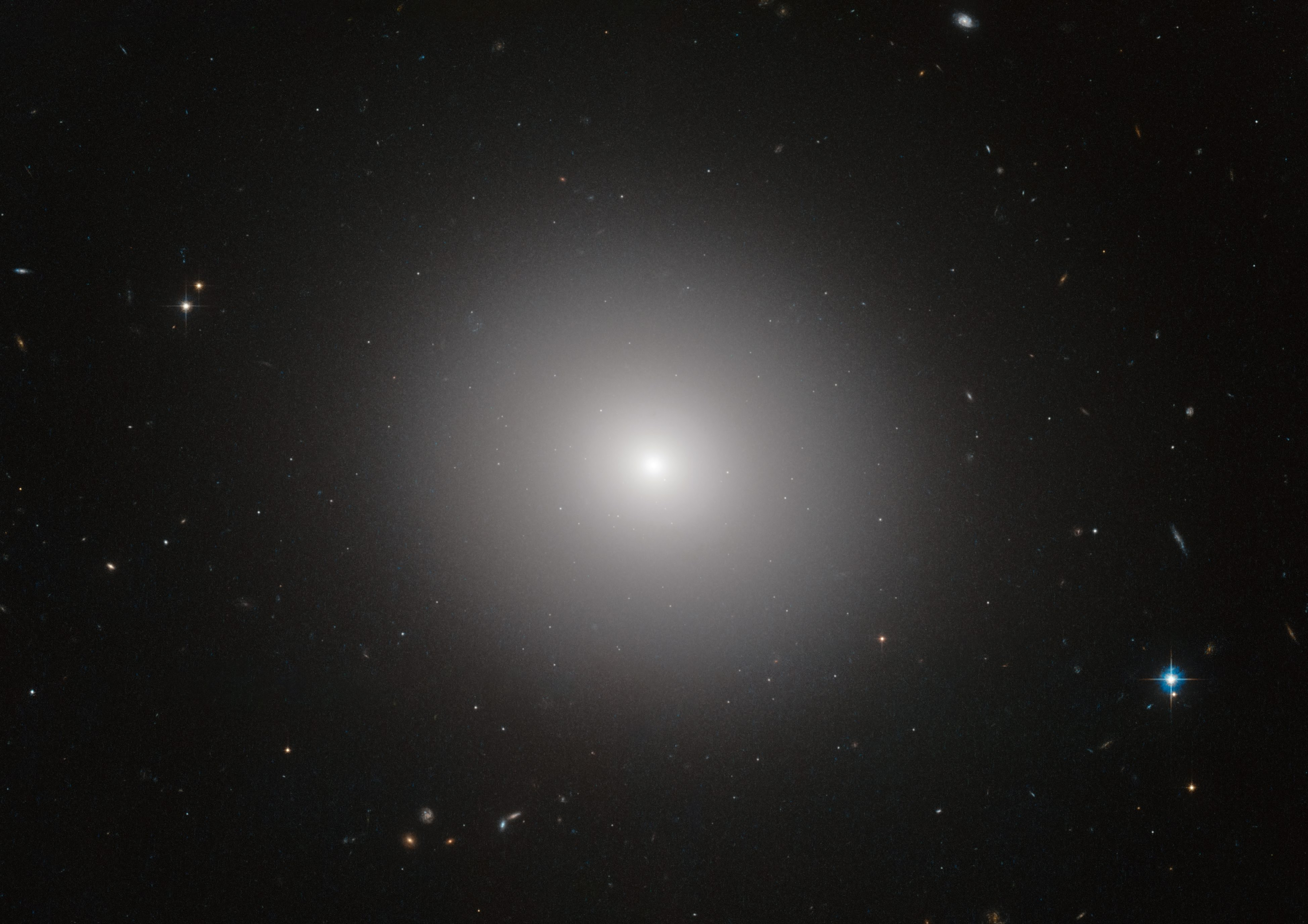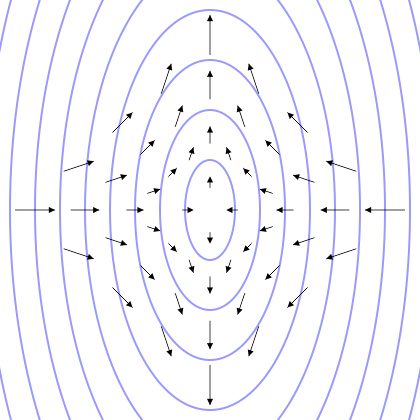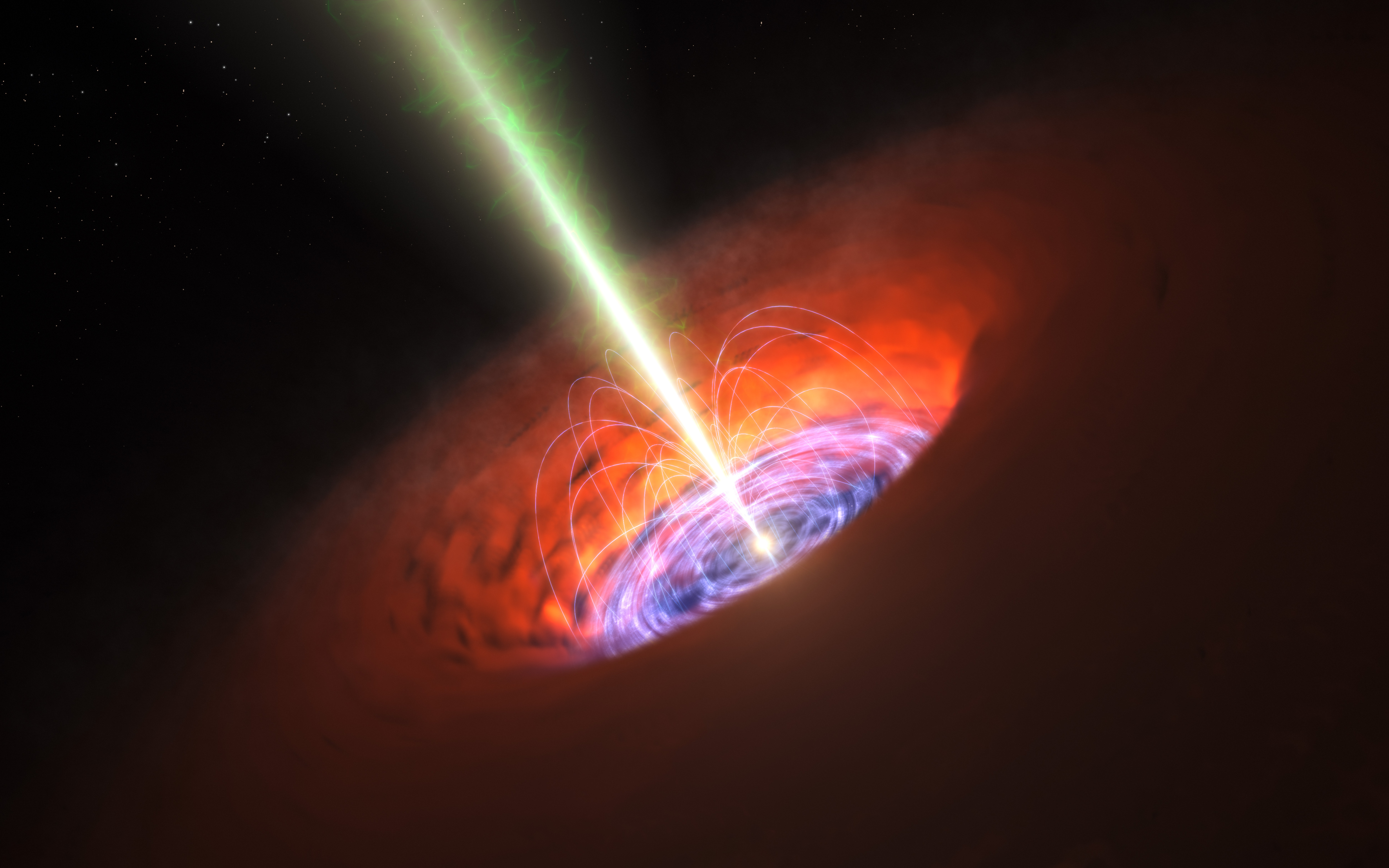|
4C 37.11
4C +37.11 or Galaxy 0402+379 is a radio galaxy and elliptical galaxy featuring binary supermassive black holes with the least separation of any directly observed binaries, as of 2006. The separation between the two is 24 light-years or 7.3 parsecs, with an orbital period of 30,000 years. The two supermassive black holes, about 750 million light years from earth, have a combined mass of about 15 billion . Other supermassive binary black hole candidates suggest the smaller separation distances expected as they eventually merge, but have not been confirmed. For example, quasar OJ 287 is inferred to have a binary supermassive black hole pair with an orbital period of 12 years, and thus be much closer together. However these have not been directly measured and additional observation, possibly over extended time periods, is needed. The eventual collision of the pair, which should stay apart for at least a few million more years, would result in strong gravitational waves. Refe ... [...More Info...] [...Related Items...] OR: [Wikipedia] [Google] [Baidu] |
J2000
In astronomy, an epoch or reference epoch is a instant, moment in time used as a reference point for some time-varying astronomical quantity. It is useful for the celestial coordinates or orbital elements of a Astronomical object, celestial body, as they are subject to Perturbation (astronomy), perturbations and vary with time. These time-varying astronomical quantities might include, for example, the mean longitude or mean anomaly of a body, the node of its orbit relative to a reference plane, the direction of the apogee or Perihelion and aphelion, aphelion of its orbit, or the size of the major axis of its orbit. The main use of astronomical quantities specified in this way is to calculate other relevant parameters of motion, in order to predict future positions and velocities. The applied tools of the disciplines of celestial mechanics or its subfield orbital mechanics (for predicting orbital paths and positions for bodies in motion under the gravitational effects of other bodi ... [...More Info...] [...Related Items...] OR: [Wikipedia] [Google] [Baidu] |
Parsecs
The parsec (symbol: pc) is a unit of length used to measure the large distances to astronomical objects outside the Solar System, approximately equal to or (au), i.e. . The parsec unit is obtained by the use of parallax and trigonometry, and is defined as the distance at which 1 au subtends an angle of one arcsecond ( of a degree). This corresponds to astronomical units, i.e. 1\, \mathrm = 1/\tan \left( \ \mathrm \right)\, \mathrm. The nearest star, Proxima Centauri, is about from the Sun. Most stars visible to the naked eye are within a few hundred parsecs of the Sun, with the most distant at a few thousand. The word ''parsec'' is a portmanteau of "parallax of one second" and was coined by the British astronomer Herbert Hall Turner in 1913 to make calculations of astronomical distances from only raw observational data easy for astronomers. Partly for this reason, it is the unit preferred in astronomy and astrophysics, though the light-year remains prominent in pop ... [...More Info...] [...Related Items...] OR: [Wikipedia] [Google] [Baidu] |
Supermassive Black Holes
A supermassive black hole (SMBH or sometimes SBH) is the largest type of black hole, with its mass being on the order of hundreds of thousands, or millions to billions of times the mass of the Sun (). Black holes are a class of astronomical objects that have undergone gravitational collapse, leaving behind spheroidal regions of space from which nothing can escape, not even light. Observational evidence indicates that almost every large galaxy has a supermassive black hole at its center. For example, the Milky Way has a supermassive black hole in its Galactic Center, corresponding to the radio source Sagittarius A*. Accretion of interstellar gas onto supermassive black holes is the process responsible for powering active galactic nuclei (AGNs) and quasars. Two supermassive black holes have been directly imaged by the Event Horizon Telescope: the black hole in the giant elliptical galaxy Messier 87 and the black hole at the Milky Way’s center. Description Supermassive black ... [...More Info...] [...Related Items...] OR: [Wikipedia] [Google] [Baidu] |
Radio Galaxies
A radio galaxy is a galaxy with giant regions of radio emission extending well beyond its visible structure. These energetic radio lobes are powered by jets from its active galactic nucleus. They have luminosities up to 1039 W at radio wavelengths between 10 MHz and 100 GHz. The radio emission is due to the synchrotron process. The observed structure in radio emission is determined by the interaction between twin jets and the external medium, modified by the effects of relativistic beaming. The host galaxies are almost exclusively large elliptical galaxies. ''Radio-loud'' active galaxies can be detected at large distances, making them valuable tools for observational cosmology. Recently, much work has been done on the effects of these objects on the intergalactic medium, particularly in galaxy groups and clusters. Alcyoneus is a low-excitation radio galaxy, identified as having the largest radio lobes found, with lobed structures spanning 5 megaparsecs (16×10 ... [...More Info...] [...Related Items...] OR: [Wikipedia] [Google] [Baidu] |
Elliptical Galaxies
An elliptical galaxy is a type of galaxy with an approximately ellipsoidal shape and a smooth, nearly featureless image. They are one of the four main classes of galaxy described by Edwin Hubble in his Hubble sequence and 1936 work ''The Realm of the Nebulae'', with their intermediate scale disks, a subset of the "early-type" galaxy population. Most elliptical galaxies are composed of older, low-mass stars, with a sparse interstellar medium and minimal star formation activity, and they tend to be surrounded by large numbers of globular clusters. Elliptical galaxies are believed to make up approximately 10–15% of galaxies in the Virgo Supercluster, and they are not the dominant type of galaxy in the universe overall. They are preferentially found close to the centers of galaxy clusters. Elliptical galaxies range in size from dwarf ellipticals with tens of millions of stars, to supergiants of over one hundred trillion stars that dominate their galaxy clusters. Originally, Ed ... [...More Info...] [...Related Items...] OR: [Wikipedia] [Google] [Baidu] |
Gravitational Waves
Gravitational waves are waves of the intensity of gravity generated by the accelerated masses of an orbital binary system that Wave propagation, propagate as waves outward from their source at the speed of light. They were first proposed by Oliver Heaviside in 1893 and then later by Henri Poincaré in 1905 as waves similar to Electromagnetic radiation, electromagnetic waves but the gravitational equivalent. Gravitational waves were later #History, predicted in 1916 by Albert Einstein on the basis of his General relativity, general theory of relativity as ripples in spacetime. Later he refused to accept gravitational waves. Gravitational waves transport energy as gravitational radiation, a form of radiant energy similar to electromagnetic radiation. Newton's law of universal gravitation, part of classical mechanics, does not provide for their existence, since that law is predicated on the assumption that Speed of gravity, physical interactions propagate instantaneously (at infinite ... [...More Info...] [...Related Items...] OR: [Wikipedia] [Google] [Baidu] |
OJ 287
OJ 287 is a BL Lac object 3.5 billion light-years from Earth that has produced quasi-periodic optical outbursts going back approximately 120 years, as first apparent on photographic plates from 1891. Seen on photographic plates since at least 1887, it was first detected at radio wavelengths during the course of the Ohio Sky Survey. It is a supermassive black hole binary. The intrinsic brightness of the flashes corresponds to over a trillion times the Sun's luminosity, greater than the entire Milky Way galaxy's light output. Characteristics Its central supermassive black hole is among the largest known, with a mass of 18.35 billion solar masses, more than six times the value calculated for the previous largest object . With such high mass, OJ 287 may fall into a proposed new classification of ultramassive black holes. Its Schwarzschild radius is ~362 AU, about 12 and 0.75 times the semimajor axes of the orbits of Neptune and dwarf planet Sedna, respectively. The optical light ... [...More Info...] [...Related Items...] OR: [Wikipedia] [Google] [Baidu] |
Quasar
A quasar is an extremely Luminosity, luminous active galactic nucleus (AGN). It is pronounced , and sometimes known as a quasi-stellar object, abbreviated QSO. This emission from a galaxy nucleus is powered by a supermassive black hole with a mass ranging from millions to tens of billions of solar masses, surrounded by a gaseous accretion disc. Gas in the disc falling towards the black hole heats up because of friction and releases energy in the form of electromagnetic radiation. The radiant energy of quasars is enormous; the most powerful quasars have luminosity, luminosities thousands of times greater than that of a galaxy such as the Milky Way. Usually, quasars are categorized as a subclass of the more general category of AGN. The redshifts of quasars are of Expansion of the universe, cosmological origin. The term originated as a Contraction (grammar), contraction of "quasi-stellar ''[star-like]'' radio source"—because quasars were first identified during the 1950s as sour ... [...More Info...] [...Related Items...] OR: [Wikipedia] [Google] [Baidu] |
Light-years
A light-year, alternatively spelled light year, is a large unit of length used to express astronomical distances and is equivalent to about 9.46 trillion kilometers (), or 5.88 trillion miles ().One trillion here is taken to be 1012 (one million million, or billion in long scale). As defined by the International Astronomical Union (IAU), a light-year is the distance that light travels in a vacuum in one Julian year (365.25 days). Because it includes the time-measurement word "year", the term ''light-year'' is sometimes misinterpreted as a unit of time. The ''light-year'' is most often used when expressing distances to stars and other distances on a galactic scale, especially in non-specialist contexts and popular science publications. The unit most commonly used in professional astronomy is the parsec (symbol: pc, about 3.26 light-years) which derives from astrometry; it is the distance at which one astronomical unit subtends an angle of one second of arc. Defini ... [...More Info...] [...Related Items...] OR: [Wikipedia] [Google] [Baidu] |
Light-year
A light-year, alternatively spelled light year, is a large unit of length used to express astronomical distances and is equivalent to about 9.46 trillion kilometers (), or 5.88 trillion miles ().One trillion here is taken to be 1012 (one million million, or billion in long scale). As defined by the International Astronomical Union (IAU), a light-year is the distance that light travels in a vacuum in one Julian year (365.25 days). Because it includes the time-measurement word "year", the term ''light-year'' is sometimes misinterpreted as a unit of time. The ''light-year'' is most often used when expressing distances to stars and other distances on a galactic scale, especially in non-specialist contexts and popular science publications. The unit most commonly used in professional astronomy is the parsec (symbol: pc, about 3.26 light-years) which derives from astrometry; it is the distance at which one astronomical unit subtends an angle of one second of arc. Defini ... [...More Info...] [...Related Items...] OR: [Wikipedia] [Google] [Baidu] |
Supermassive Black Hole
A supermassive black hole (SMBH or sometimes SBH) is the largest type of black hole, with its mass being on the order of hundreds of thousands, or millions to billions of times the mass of the Sun (). Black holes are a class of astronomical objects that have undergone gravitational collapse, leaving behind spheroidal regions of space from which nothing can escape, not even light. Observational evidence indicates that almost every large galaxy has a supermassive black hole at its Central massive object, center. For example, the Milky Way has a Galactic Center#Supermassive black hole, supermassive black hole in its Galactic Center, corresponding to the Astronomical radio source, radio source Sagittarius A*. Accretion (astrophysics), Accretion of Interstellar medium, interstellar gas onto supermassive black holes is the process responsible for powering Active galactic nucleus, active galactic nuclei (AGNs) and quasars. Two supermassive black holes have been directly imaged by the ... [...More Info...] [...Related Items...] OR: [Wikipedia] [Google] [Baidu] |
Elliptical Galaxy
An elliptical galaxy is a type of galaxy with an approximately ellipsoidal shape and a smooth, nearly featureless image. They are one of the four main classes of galaxy described by Edwin Hubble in his Hubble sequence and 1936 work ''The Realm of the Nebulae'', with their intermediate scale disks, a subset of the "early-type" galaxy population. Most elliptical galaxies are composed of older, low-mass stars, with a sparse interstellar medium and minimal star formation activity, and they tend to be surrounded by large numbers of globular clusters. Elliptical galaxies are believed to make up approximately 10–15% of galaxies in the Virgo Supercluster, and they are not the dominant type of galaxy in the universe overall. They are preferentially found close to the centers of galaxy clusters. Elliptical galaxies range in size from dwarf ellipticals with tens of millions of stars, to supergiants of over one hundred trillion stars that dominate their galaxy clusters. Original ... [...More Info...] [...Related Items...] OR: [Wikipedia] [Google] [Baidu] |







